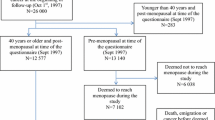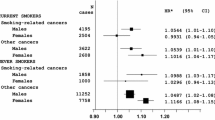Abstract
Purpose
To investigate the associations of anthropometric factors and physical activity with risk of thyroid cancer in a large prospective study.
Methods
We examined these associations with risk of incident thyroid cancer in a cohort of 144,319 postmenopausal women enrolled in the Women’s Health Initiative. Cox proportional hazards models were used to estimate hazard ratios (HRs) and 95% confidence intervals (95% CI) for factors of interest with risk of all thyroid cancer (n = 294) and of the two major subtypes: papillary (n = 245) and follicular thyroid cancer (n = 32).
Results
After adjustment for covariates, measured height at baseline was positively associated with thyroid cancer overall (HR for highest vs. lowest quartile 1.48, 95% CI 1.04–2.13, p for trend 0.02) and with papillary carcinoma (HR 1.49, 95% CI 1.01–2.21, p for trend 0.03, respectively). For each 5 cm-increase in height, the HR for all thyroid cancer was 1.15, 95% CI 1.04–1.27 and for papillary thyroid cancer was 1.14, 95% CI 1.03–1.27. In addition, self-reported weight at age 18 was positively associated with risk of papillary thyroid cancer. In contrast, baseline weight, body mass index, waist circumference, hip circumference, waist-hip ratio, weight change from age 18 to baseline, and level of self-reported recreational physical activity were not associated with risk.
Conclusions
Our results suggest that attained stature is a risk factor for thyroid cancer in postmenopausal women. This association may reflect the influence of either genetic or environmental factors in early life on risk of thyroid cancer.
Similar content being viewed by others
References
American Cancer Society (2009) Cancer facts and figures 2009. American Cancer Society, Atlanta
Ron E, Schneider AB (2006) Thyroid cancer. In: Schottenfeld D, Fraumeni JF Jr (eds) Cancer epidemiology and prevention. Oxford University Press, New York, pp 975–994
Kohler BA, Ward E, McCarthy BJ et al (2011) Annual report to the nation on the status of cancer, 1975–2007, featuring tumors of the brain and other nervous system. J Natl Cancer Inst 103:714–736
Dal Maso L, Bosetti C, La Vecchia C, Franceschi S (2009) Risk factors for thyroid cancer: an epidemiological review focused on nutritional factors. Cancer Causes Control 20:75–86
Cramer JD, Fu P, Harth KC et al (2010) Analysis of the rising incidence of thyroid cancer using the surveillance, epidemiology and end results national cancer data registry. Surgery 148:1147–1153
Enewold L, Zhu K, Ron E et al (2009) Rising thyroid cancer incidence in the United States by demographic and tumor characteristics, 1980–2005. Cancer Epidemiol Biomarkers Prev 18:784–791
Flegal KM, Carroll MD, Kuczmarski RJ, Johnson CL (1998) Overweight and obesity in the United States: prevalence and trends, 1960–1994. Int J Obes Relat Metab Disord 22(1):39–47
Ogden CL, Carroll MD, Curtin LR et al (2006) Prevalence of overweight and obesity in the United States, 1999–2004. JAMA 295(13):1549–1555
Goodman MT, Kolonel LN, Wilkens LR (1992) The association of body size, reproductive factors and thyroid cancer. Br J Cancer 66(6):1180–1184
Tulinius H, Sigfusson N, Sigvaldason H et al (1997) Risk factors for malignant diseases: a cohort study on a population of 22, 946 Icelanders. Cancer Epidemiol Biomarkers Prev 6(11):863–873
Dal Maso L, La Vecchia C, Franceschi S et al (2000) A pooled analysis of thyroid cancer studies. V. Anthropometric factors. Cancer Causes Control 11(2):137–144
Iribarren C, Haselkorn T, Tekawa IS, Friedman GD (2001) Cohort study of thyroid cancer in a San Francisco Bay area population. Int J Cancer 93(5):745–750
Oh SW, Yoon YS, Shin SA (2005) Effects of excess weight on cancer incidences depending on cancer sites and histologic findings among men: Korea national health insurance corporation study. J Clin Oncol 23(21):4742–4754
Rapp K, Schroeder J, Klenk J et al (2005) Obesity and incidence of cancer: a large cohort study of over 145, 000 adults in Austria. Br J Cancer 93(9):1062–1067
Engeland A, Tretli S, Akslen LA, Bjorge T (2006) Body size and thyroid cancer in two million Norwegian men and women. Br J Cancer 95(3):366–370
Samanic C, Chow WH, Gridley G et al (2006) Relation of body mass index to cancer risk in 362, 552 Swedish men. Cancer Causes Control 17(7):901–909
Guignard R, Truong T, Rougier Y et al (2007) Alcohol drinking, tobacco smoking, and anthropometric characteristics as risk factors for thyroid cancer: a countrywide case-control study in New Caledonia. Am J Epidemiol 166(10):1140–1149
Suzuki T, Matsuo K, Hasegawa Y et al (2008) Anthropometric factors at age 20 years and risk of thyroid cancer. Cancer Causes Control 19(10):1233–1242
Sung J, Song YM, Lawlor DA et al (2009) Height and site-specific cancer risk: a cohort study of a Korean adult population. Am J Epidemiol 170(1):53–64
Brindel P, Doyon F, Rachedi F et al (2009) Anthropometric factors in differentiated thyroid cancer in French Polynesia: a case-control study. Cancer Causes Control 20(5):581–590
Clavel-Chapelon F, Guillas G, Tondeur L et al (2010) Risk of differentiated thyroid cancer in relation to adult weight, height and body shape over life: the French E3 N cohort. Int J Cancer 126(12):2984–2990
Leitzmann MF, Brenner A, Moore SC et al (2010) Prospective study of body mass index, physical activity and thyroid cancer. Int J Cancer 126(12):2947–2956
Meinhold CL, Ron E, Schonfeld SJ et al (2010) Nonradiation risk factors for thyroid cancer in the US radiologic technologists study. Am J Epidemiol 171(2):242–252
Kitahara CM, Platz EA, Park Y, et al. (2011) Body fat distribution, weight change during adulthood, and thyroid cancer risk in the NIH-AARP Diet and Health Study. Int J Cancer. doi:10.1002/ijc.26161
Kitahara CM, Platz EA, Freeman LE et al (2011) Obesity and thyroid cancer risk among US men and women: a pooled analysis of five prospective studies. Cancer Epidemiol Biomarkers Prev 20(3):464–472
Rossing MA, Remler R, Voigt LF et al (2001) Recreational physical activity and risk of papillary thyroid cancer (United States). Cancer Causes Control 12(10):881–885
Baglietto L, English DR, Hopper JL et al (2009) Circulating steroid hormone concentrations in postmenopausal women in relation to body size and composition. Breast Cancer Res Treat 115(1):171–179
Boyapati SM, Shu XO, Gao YT et al (2004) Correlation of blood sex steroid hormones with body size, body fat distribution, and other known risk factors for breast cancer in post-menopausal Chinese women. Cancer Causes Control 15(3):305–311
Renehan AG, Frystyk J, Flyvbjerg A (2006) Obesity and cancer risk: the role of the insulin-IGF axis. Trends Endocrinol Metab 17(8):328–336
Gunnell D, Okasha M, Smith GD et al (2001) Height, leg length, and cancer risk: a systematic review. Epidemiol Rev 23(2):313–342
Manole D, Schildknecht B, Gosnell B et al (2001) Estrogen promotes growth of human thyroid tumor cells by different molecular mechanisms. J Clin Endocrinol Metab 86(3):1072–1077
Ciampolillo A, De Tullio C, Perlino E, Maiorano E (2007) The IGF-I axis in thyroid carcinoma. Curr Pharm Des 13(7):729–735
Hursting SD, Lashinger LM, Wheatley KW et al (2008) Reducing the weight of cancer: mechanistic targets for breaking the obesity-carcinogenesis link. Best Practice Res Clin Endocrinol Metab 22(4):659–669
Balkau B, Mhamdi L, Oppert J-M et al (2008) Physical activity and insulin sensitivity. Diabetes 57:2613–2618
The Women’s Health Initiative Study Group (1998) Design of the women’s health initiative clinical trial and observational study. Control Clin Trials 19(1):61–109
Langer RD, White E, Lewis CE et al (2003) The women’s health initiative observational study: baseline characteristics of participants and reliability of baseline measures. Ann Epidemiol 13(9 Suppl):S107–S121
Morimoto LM, White E, Chen Z et al (2002) Obesity, body size, and risk of postmenopausal breast cancer: the women’s health Initiative (United States). Cancer Causes Control 13:741–751
McTiernan A, Kooperberg C, White E et al (2003) Recreational physical activity and the risk of breast cancer in postmenopausal women: the women’s health initiative Cohort study. JAMA 290(10):1331–1336
Curb JD, McTiernan A, Heckbert SR et al (2003) Outcomes ascertainment and adjudication methods in the women’s health initiative. Ann Epidemiol 13(9 Suppl):S122–S128
Renehan AG (2011) Height and cancer: consistent links, but mechanisms unclear. Lancet Oncol 12(8):716–717
Green J, Cairns BJ, Casabonne D et al (2011) Height and cancer incidence in the million women study: prospective Cohort, and meta-analysis of prospective studies of height and total cancer risk. Lancet Oncol 12(8):785–794
Hoppe C, Udam TR, Lauritzen L et al (2004) Animal protein intake, serum insulin-like growth factor I, and growth in healthy 2.5-year-old Danish children. Am J Clin Nutr 80(2):447–452
Rogers I, Metcalfe C, Gunnell D et al (2006) Insulin-like growth factor-I and growth in height, leg length, and trunk length between ages 5 and 10 years. J Clin Endocrinol Metab 91(7):2514–2519
Buckbinder L, Talbott R, Velasco-Miguel S et al (1995) Induction of the growth inhibitor IGF-binding protein 3 by p53. Nature 377(6550):646–649
Author information
Authors and Affiliations
Corresponding author
Appendix: Short list of WHI investigators
Appendix: Short list of WHI investigators
Program Office
(National Heart, Lung, and Blood Institute, Bethesda, Maryland) Jacques Rossouw, Shari Ludlam, Dale Burwen, Joan McGowan, Leslie Ford, and Nancy Geller.
Clinical Coordinating Center: Clinical Coordinating Center
(Fred Hutchinson Cancer Research Center, Seattle, WA) Garnet Anderson, Ross Prentice, Andrea LaCroix, and Charles Kooperberg.
Investigators and Academic Centers
(Brigham and Women’s Hospital, Harvard Medical School, Boston, MA) JoAnn E. Manson; (MedStar Health Research Institute/Howard University, Washington, DC) Barbara V. Howard; (Stanford Prevention Research Center, Stanford, CA) Marcia L. Stefanick; (The Ohio State University, Columbus, OH) Rebecca Jackson; (University of Arizona, Tucson/Phoenix, AZ) Cynthia A. Thomson; (University at Buffalo, Buffalo, NY) Jean Wactawski-Wende; (University of Florida, Gainesville/Jacksonville, FL) Marian Limacher; (University of Iowa, Iowa City/Davenport, IA) Robert Wallace; (University of Pittsburgh, Pittsburgh, PA) Lewis Kuller; (Wake Forest University School of Medicine, Winston-Salem, NC) Sally Shumaker.
Women’s Health Initiative Memory Study
(Wake Forest University School of Medicine, Winston-Salem, NC) Sally Shumaker.
Rights and permissions
About this article
Cite this article
Kabat, G.C., Kim, M.Y., Thomson, C.A. et al. Anthropometric factors and physical activity and risk of thyroid cancer in postmenopausal women. Cancer Causes Control 23, 421–430 (2012). https://doi.org/10.1007/s10552-011-9890-9
Received:
Accepted:
Published:
Issue Date:
DOI: https://doi.org/10.1007/s10552-011-9890-9




